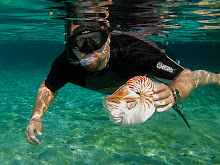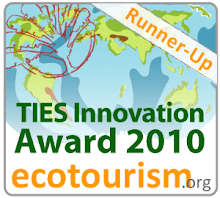 |
| Kenya turtles from Flip-flops © Watamu Marine Association |
This past month I finally saw many of the marine debris sea turtles that we asked students and community groups around the globe to create. This project was funded through a
2010 SWOT Education and Outreach grant that I wrote for
Oceanic Society this past October. Our proposal was to have various groups from coastal and island communities around the globe collect marine debris from their local beaches and then construct a sea turtle art project out of it. The idea was to focus some attention to the impact plastic pollution (the main component of marine debris) has on sea turtles and their nesting habitats (tropical beach areas). We had 7 groups participate, 2 from Hawaii, and 1 each from
Kenya,
Suriname,
Palau,
Belize, and
Costa Rica. Most of the groups participating were students but a few were community organizations or in the case of Palau a group of dive guides from
Fish'n'Fins. The art they all created was truly inspirational. Along the way each group documented their participation with photos and in some cases
video. One of the wonderful parts of this program was that many of the students organized beach collections of marine debris in order to have material to make these turtles.
 | |
| Surinamese students collecting marine debris. |
|
|
|
|
 |
| Costa Rica students collecting debris |
 |
| Hatchlings trapped in plastic trash Galibi, Suriname ©Sentman | |
|
|
These photos show two of our student groups collecting marine debris off of local beaches. These beaches are also nesting areas for sea turtle populations. When the students went out to collect debris they made first hand field observations about the amount and types of plastic pollution they were able to find on their beaches. The volume and diversity of trash made clear to the participating groups just how large a problem plastic pollution is becoming throughout the worlds oceans. Photos like the two here illustrate how both adult and hatchling turtles are at risk from trash that washes up in their resting and nesting locations around the globe. Marine debris is not just an entanglement hazard to turtles swimming in the ocean but
 |
| Rope washed up on Hawaiian beach. © 2010 Wayne Sentman |
also can trap hatchlings as they emerge from nests and attempt to make their way back to the ocean. Increasingly plastic pollution that makes it way into the ocean is also finding its way into the marine food chain and is even being ingested directly by sea turtles.
A recent article calls the sea turtle the new "albatross" of the seas. This as we are starting to find turtles,
that like the Laysan and Blackfooted Albatross of the Northwest Hawaiian islands also have stomachs full of plastic. Given that plastic can take 20 to 1000 years to break down in the oceans it is very likely that almost all of the plastic produced by man that has EVER ended up in our seas is still there. Given the scope of the problem plastic pollution posses to human and wildlife populations the marine debris sea turtle artwork created by the various groups proved very inspirational, serving to remind us that art can offer a unique interpretation of environmental problems. An interpretation that hopefully inspires the viewer to find solutions and change behaviors (reduce use of single-use plastics) rather than be overwhelmed by the problem. To follow are pictures of the art the students created with the debris that they collected.
 |
| Gayle Bornovski who oversaw the Palau art project holding the Fishing Float hatchling. |
 |
| The "Leatherback" from Suriname with a ribbed carapace made from beach collected plastic water bottles. |
 |
| Oahu Students with their Marine Debris Sea Turtles |
 |
| Belize students "Turtle" (back left) and Story board they made to go with it. Kenya and Palau turtles in foreground. |
 |
| International Students in Costa Rica with their Marine Debris Turtle. |
 |
| Molokai High School Creation - Ho'olehua, Hawaii |
 |
| Marine Debris Sea Turtles on Display at the 5IMDC |
With all of the wonderful art that was made, we managed to display some of the items at the
5th International Marine Debris Conference that was held in Honolulu, Hawaii over the 20 - 25 March. Additionally the two Kenya turtles (pictured at the top of this blog post) made under the direction of professional artist Andrew McNaughton and with help from the
Umoja Curio Sellers and the
Watamu Marine Association Community Waste Management and Recycling Project ended up continuing their journey around the globe. They were assisted in this migration by new friends in Hong Kong, where they will be utilized to promote
community involvement with coastal beach clean-up projects planned for 2011 and 2012. These events will be planned in part by
ECOZINE. Currently the Belize and Palau turtles are being exhibited at the
31st Annual Sea Turtle Symposium on Sea Turtle Biology & Conservation in San Diego, CA.
I am so happy that so many great groups, teachers, and artists contributed to this project. And thanks to their efforts to clean up the beaches in their own backyard used by sea turtles around the globe. A good article that sums up the complete scope of threats to marine turtles can be found on the
BioScience website.













